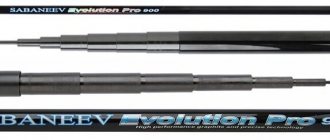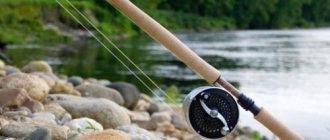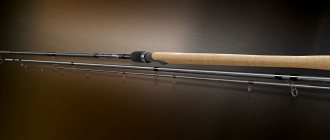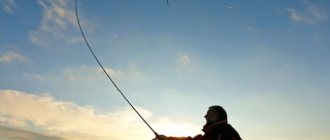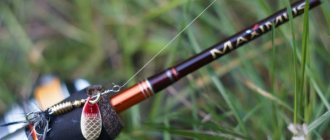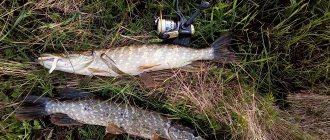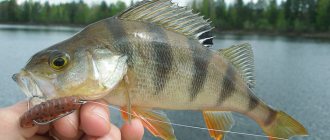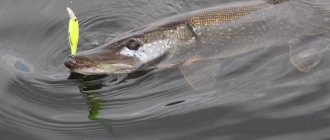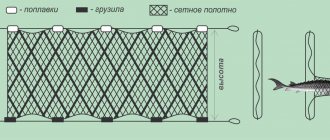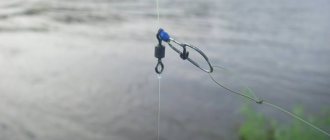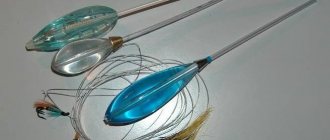Bombarda (another name is sbirulino) was originally invented by the Italians to catch wary trout. But in the conditions of our reservoirs it is actively used for asp, ide, and chub.
The tackle is designed for long casts, which allows you to lure a cunning asp out of reed thickets, where you simply cannot reach with a regular fishing rod.
In this article we will look at what bombarda is and what types it is divided into. Let's learn the secrets of active biting with a bombard, the principle of assembly and the technique of fishing with this tackle.
A fishing bombard looks like a heavy float, only with a tube turned upside down through which the main fishing line passes.
It reminds everyone very much of the usual inline feeder tackle, where the feeder was replaced with a bombard. The leash sometimes reaches up to 1.5 m, depending on who is fishing and at what depths.
The main function is to deliver light bait over long distances, where it cannot be reached with a simple fishing rod.
Used as a separate tackle or as an addition to a spinning rod.
This is an excellent fishing option at a distance of 40 m or more from the shore.
Types of bombards for fishing

Bombarda floats for fishing are divided into 4 main types according to weight category, size, and behavior in the water.
It is worth highlighting the following:
- Surface (floating).
Most often used in shallow areas of the reservoir or where the bait does not need to be immersed more than 1.5 m. - Slowly falling.
Suitable for searching for fish on fairways and rifts. Ideally works for predators, especially perch and ide, which like to stand near fast currents. - Sinking quickly.
Well suited for fishing in bodies of water with fast currents from the bottom, using stepped fishing when you need to get into the water column. - Adjustable (fill-in).
Water is poured in there. The more water, the deeper the bombard goes. They act excellently as a suspender.
The fish is constantly in motion, sometimes in the water column, sometimes on the surface. And predators such as pike perch or perch generally lead a bottom-dwelling lifestyle. Therefore, fishermen have to constantly adapt to fishing and alternate types of gear for a successful fishing outcome.
The principle of installing a bombard for fishing
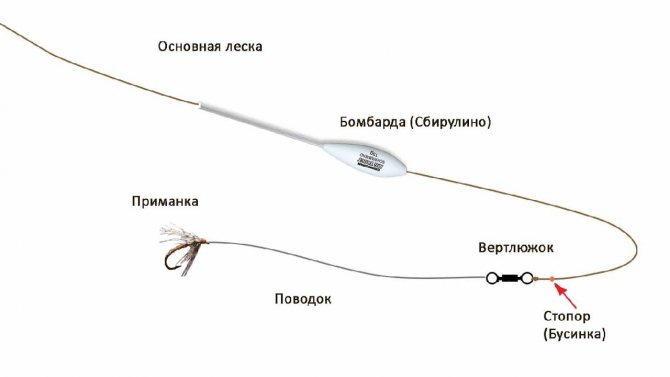
The principle of installing a bombard for fishing is quick and easy, but requires attention and accuracy.
The main elements of the bombard:
- main line;
- float stoppers or beads;
- swivels;
- fasteners;
- leash (fluorocarbon);
- bait or hook.
Installation can be done in two ways:
- removable;
- whole.
In case of removable installation, after the stoppers there are swivels with fasteners. This is necessary to change bombards in different fishing conditions.
But most often, anglers use a one-piece rig because they fish in the same places. In addition, this approach is considered more sensitive.
Installation sequence:
- The main cord is pulled into the first stopper to avoid the line being pulled from the tackle to the rod.
- Next, the cord goes into the bombard from the side of the long tube. A long tube is needed to ensure that the tackle does not twist during flight.
- If the bombard is wet, then it is better to stretch it with a loop of thin fishing line.
- The cord passes through a second stopper or rubber bead to prevent damage to the knot from the bombard.
- A swivel is attached. Most anglers use 2 swivels for less twist on the fluorocarbon, from which on the other side comes a leader with bait or a hook.
The thickness of the leash is adjusted to the expected catch.
Lures and groundbait
Pre-feeding gives good results when fishing for mullet. The composition can be purchased at the store or made independently. The base should create a fragrant, attractive stain. But in order to keep a school of nimble fish on it, it is necessary to add to the bait the meat of crayfish and shells, bread crumb, offal of any fish, as well as the bait that is used during fishing. It is optimal to attach fish within 2-3 days, throwing bait at the same time. The mullet quickly gets used to the treat; all that remains is to accurately cast the bait with the hook onto the feeding point.
Bait, lures, and artificial lures can be used for fishing.
- One of the main baits of Black Sea fishermen is the sea worm. It is mined in muddy deposits at the bottom of estuaries. The worm can be stored for a long time in cold water or vodka. The alcohol-containing liquid preserves the bait, allowing it to be used at any time of the year. Animal baits include the usual earthworm, crab meat, fish, mussels and shrimp.
- For vegetable baits, fishermen use white bread crumbs and various types of dough.
- Among the artificial baits required for bombard fishing are silicone worms and fish, as well as small spinners.
Bombard fishing rod
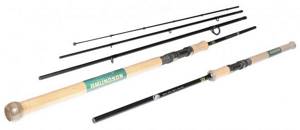
Fishing stores sell special rods for bombard fishing. As a rule, their length is more than 3 m. They have very soft and flexible forms for casting range and convenient landing of fish. To make fishing comfortable, you need to take a light rod.
But at the same time, the spinning rod or fishing rod test must correspond to the weight range. If a bombard is used from 10 to 45 g, then the rod should be taken with exactly this test (preferably with a margin of plus 5 g).
This way the fisherman will feel the bite well and not be afraid of breaking the spinning rod.
Practice shows that medium action spinning rods are best suited.
As for the length of the rod, you should understand that if the leash is 1.5 m, then the length of the spinning rod should be no less than 3.5 m.
Ideally, the rod should be 2.5 times longer than the leader, otherwise long casting will be problematic.
You can also use domestic three-meter spinning rods, but make leashes approximately 1 m, especially if fishing on a small or medium-sized river.
A reel for long-distance casting must be inertia-free with a spool diameter of 2000 to 3000 thousand (according to Shimano classification). But this is not important, if we are talking about a small river, then a 1000 spool size will do.
Gear used
Having decided on the most suitable fishing method, it is necessary to begin implementing the planned plan. First of all, you need to collect working gear.
Float rod
A catchable float rod is based on a long, lightweight rod.
- Carbon fiber fly sticks 7-8 m long are best suited. Since you will be hunting for small fish, the equipment can be tied directly to the tip of the fishing rod. It is advisable to install a reel when the casting distance exceeds 14-15 m. The thickness of the monofilament line should not exceed 0.16 mm, and the leash can be made of nylon thread with a diameter of 0.12 mm.
- The choice of hook is determined by the bait used. The most commonly used models are No. 6-8, which have a long fore-end.
- On sea waves, the float requires not only good visibility, but also stability. Some anglers use match fishing models called Wagler. Local mullet hunters make homemade floats, the body of which resembles an inverted pear.
Photo 2. Wagler type float.
Bottom tackle
Catching mullet with bottom tackle looks more primitive. When equipped, you can use inexpensive fishing accessories.
- A telescopic spinning rod or a budget feeder with a length of 3.0-4.5 m is suitable for the role of a fishing rod. The test load is limited to the range from 50 to 200 g.
Photo 3. Powerful composite feeder.
- You can monitor the bite by the bend of the fishing rod tip or by the sound of the bell.
Bombard
For catching mullet in the Black Sea, the increasingly popular sbirulino or bombard tackle has proven itself well.
- The basis is a sbirulin rod up to 4.5 m long. It should have a parabolic action and a sensitive tip.
- 50-100 m of 0.20-0.25 mm monofilament line is wound onto a spinning reel with a 3000 spool.
- The float is chosen to sink slowly, so that during retrieval it is possible to deliver the bait to different horizons.
- A swivel is mounted at the end of the main fishing line, to which a leash made of 0.16-0.18 mm nylon fishing line is attached. Its length varies between 1-2 m.
Bombard fishing technique
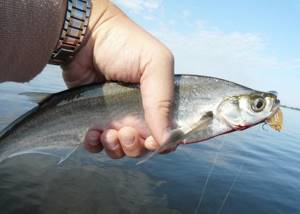
Catching and casting with a bombard represents the compatibility of spinning and fly fishing techniques for catching trophies. The qualities of casting using a spinning reel and a soft blank are taken from the spinning rod, but instead of a heavy bait, a Sbirulino float is used. Miniature baits (flies, leeches, maggots) were taken from fly fishing.
To cast:
- The cord with the tackle is wound smoothly behind the back.
- The length of the tackle should be no more than half the spinning rod. Under this condition, the grass and branches from behind will not cling, and the cast will be as far as possible.
- After a smooth pause, when the cord and the spinning rod are in one row, a soft but biting throw is made.
If you are fishing from a boat, then you can simply cast lightly and let the bait float, playing with the speed of the current.
The fishing line or cord must be slowed down before the bombard falls onto the water. This is necessary so that the bait overtakes the heavy tackle and flies forward without tangling the sirulino.
It is important to understand that the wiring for each fish is selected individually, as well as the nuances of playing with a blank. You can play with the bait every now and then quickly, then slowly, forcing it to imitate live bait. It also works well by stretching steps - this imitates a weak bug or fish, which is what the fish most often pays attention to.
Quite often the fish takes it when the retrieve goes like a snake; chub and ide especially like this.
Fishermen most often use the following as bait in domestic reservoirs:
- maggot;
- May beetle;
- worm;
- front sight;
- miniature turntables;
- small wobblers.
The behavior of the bait directly affects where the bombard’s center of gravity is and how it holds in the water. If the bombard lies down after casting, it means that the center of gravity is in the middle, and the bait will go softer and calmer. If the weight is at the end, then the bait will move rougher, and the game will be more active.
Habitats and feeding areas
Amateur mullet fishing in the Black Sea can be carried out with the arrival of spring until late autumn. Some fishermen continue to visit the estuaries in winter.
- A distinctive feature of pelengas, mullet, singil and sharpnose is their proximity to the shore. But, despite the fact that in the morning the fish swims at a meter depth, it is very careful. It is enough for one person to come close to the water for the flock to go deeper.
- You can find mullet not only in sea waters, but also in estuaries, river mouths, bays and other bodies of water connected to the sea. The most catchable places are considered to be river mouths, where a lot of nutritious organic matter enters the sea.
- When choosing a promising area for fishing, you should also take into account the direction of the currents. After all, along with the flow of water, the smallest food of interest to schools of mullet also moves.
- Artificial structures such as piers, breakwaters and groins can become attractive for fishing. Here you can fish at a fairly close distance.
This is interesting! Experienced fishermen do not miss the opportunity to enjoy catching mullet during a light storm. The fish loses caution and actively feeds.
- Depending on the time of day, it is better to fish in the morning and evening. At this time, the largest representatives of this species approach the shore. Although during the day, flocks may approach and move away from the coastline more than once in search of food.
Advantages and disadvantages of bombards for fishing
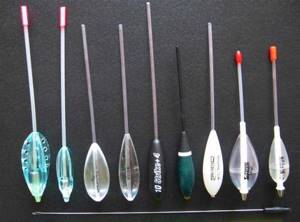
The list of advantages of bombards for fishing includes:
- Delivery of very light bait over a distance of more than 40 meters. No other spinning tackle is capable of this.
- Possibility of using a large number of wiring.
- Huge selection of baits and lures.
- Arouses interest even among the most cautious predators.
- Fishing will be successful even using inexpensive fishing rods. Provided that the length and form allow.
- The bombard can be fished at any depth with different currents and in still water.
- Possibility of homemade bombard assembly. With the right approach, its catchability will not be inferior to store-bought analogues.
Among the disadvantages of bombards, fishermen note:
- The length of the spinning rod should be from 3 m, which significantly narrows the fishing of promising areas of the reservoir
- Casting with long leashes is not always convenient and requires experience. For this reason, beginners often encounter overwhelm.
- Fishing with large baits is not carried out.
But these disadvantages are not significant against the background of so many advantages. And with the acquisition of experience in fishing, they will be completely eliminated.
Ways to catch garfish
Garfish are unpretentious and can be successfully caught from the shore from the last month of summer until the end of winter. Weather and time of day do not play a special role. A strong wave and gusts of wind can be more of a hindrance. How to catch a predator? There are different methods that require certain devices, equipment, and technology. Fishing is considered the most effective:
This is interesting: sujuk recipe at home
The first types of gear for garfish are optimal for fishing from the shore - coastal rocks, piers. It is convenient to use the tyrant when fishing from a boat. Each method has its own subtleties of equipment and specific techniques. Annual competitions for catching this fish are held in Yalta. It arouses sporting interest among professionals and attracts gambling enthusiasts with its activity.
Photo 1. Fishing rod for fishing from the seashore.
Do-it-yourself bombard for fishing
Any fisherman who has once made homemade tackle and floats can easily cope with making a bombard for fishing with his own hands. And the only cost is the fisherman’s time.
Tools that may be needed to make gear:
- screwdriver or awl;
- vice for convenience;
- knife;
- sandpaper.
An ampoule from a gel pen or any other tube within 2–3.5 mm with an internal diameter will be suitable as a tube.
The main body can be made from the following materials:
- tree;
- Styrofoam;
- 3-4 cc syringe;
- broken float of large weight;
- epoxy resin;
- Thick plastic from Kinder Surprise.
To assemble a foam bombard with your own hands you will need:
- Take hard foam and an empty ampoule from under the gel pen.
- Using a knife, cut a rectangle 6 cm long.
- Carefully grind the workpiece with sandpaper to an oval shape.
- Use an awl to pierce a hole the size of the ampoule through the center.
- Insert the ampoule into the product completely. The length of the ampoule is just right (15–20 cm).
- Take out the ampoule. Spread with glue that does not corrode foam products.
- Insert the ampoule and use lead to catch the float to the desired weight.
You can make a bombard from a regular sliding float.
To do this, cut off the bottom part and slightly up the float so that the cord can be pulled through it. Using lead or tungsten it is weighted to the required weight. The product is ready.
{banner_vnutri-kontenta-3}
There is an option for creating a self-made liquid bombard:
- Take a Kinder Surprise box and a tube with a diameter of 3 mm and a length of 17 cm.
- A hole is made in the box on both sides for the tube.
- The tube is inserted all the way to the edge and secured with epoxy resin.
- Another hole is made for running water, for weighting and depth adjustment.
- The water hole is closed with a homemade silicone or rubber stopper.
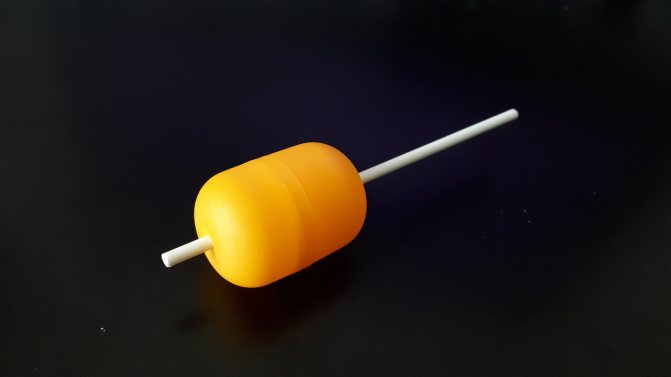
An interesting way of making from dense plastic and epoxy resin:
- Take a wide writing pen or tube with a diameter of 1.5–2 cm.
- Epoxy resin is poured into the internal cavity. Time is given to harden.
- The hardened epoxy resin is carefully knocked out of the handle. Sanded to full shape.
- The product is inserted into a vice.
- A hole is drilled in the center without disturbing the axis.
- A tube is placed in the hole using epoxy or waterproof glue. Ready.
Any of the methods does not require the purchase of materials or accessories. Therefore, fishermen often make several bombards from various available materials.
Anglers' recommendations
When going for trophies, it is worth considering the following recommendations from anglers:
- For large fish, even though the bait is small, you should use a fluorocarbon leader with a thickness of 0.3 mm and a length of at least 1.5 meters.
- It is better to make sports equipment removable, with two swivels and carbines for quickly changing weight.
- If the rod is not long, then you can magnetize the hook and attract it to the sbirulino before casting (if the bombard has a metal part) so that it does not interfere during the cast and does not cling to the grass. When it hits the water, it is released from the main gear.
- As the main one, it is better to use a cord rather than a fishing line. It is more sensitive and gives a hook immediately.
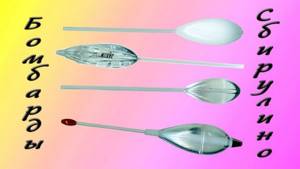
Sbirulino (bombarda) is an ideal tackle for long casts, small baits and cautious fish. Their prices vary, but assembling them yourself is not difficult. For those fishermen who have not yet tried to catch asp and chub, this tackle will be the best option for success.
Samodur is the best tackle for catching garfish in the open sea
Samodur is a tackle that is used for fishing from a boat. This method is quite effective and convenient because it can be used constantly, because most of the time the fish lives in the open sea. Tyrant fishing for garfish does not necessarily imply the use of hooks. Bundles of plastic threads and sponges, in which the fish get very entangled, have proven themselves to be quite good. From such tangles you can get absolutely whole fish.
Photo 3. Fishing with a tyrant from a boat.
Optimal fishing line with a diameter of up to 0.25 mm. Using a tyrant and tracking the movement of the flock, you can fish a considerable area of water, moving the gear in the direction of the movement of the flock.
Any method of catching garfish is active and brings fishermen a lot of pleasure and excitement. The main thing is to correctly apply the advice of experienced fishermen in practice and not forget about the features of each method. If you like to catch predators from the shore, then set aside time for this in late summer or early autumn.
